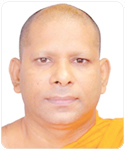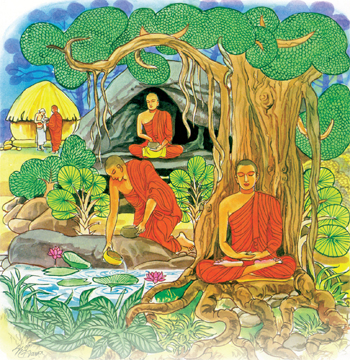The Significance Of "Vas" Observance
Of The Maha Sangha
 Senior Lecturer, Pandit, Senior Lecturer, Pandit,
Faculty of Humanities and Social Sciences
University of Sri Jayewardenepura
Dr. Ven. Dodamgoda SumanasaraThero
The season of Vassana or the Vas retreat is a valuable period for all the
Buddhist monks, nuns, and Buddhist lay devotees all over the world to engage in
religious observances spiritually. Also, they can practice religious activities
to accumulate merit.
All the monks who have received the higher ordination (upasampada) are eligible
to observe Vas during the three months of the rainy season from the Esala Full
Moon Day to the Vap Full Moon Day every year respectively. This three-month
period is referred to in Pali as ‘Vassana’ (retreat or rainy season), and in
Sinhala as ‘Vas kalaya’. According to the Buddha’s advice mentioned in the
Vassupanaikakkanda of the Mahavagga Pali, the monks should observe Vas in two
periods, namely ‘Pera Vas’ and ‘Pasu Vas’ either on the Esala Full Moon Day or
the Nikini Full Moon Day. The latter Vas observance (Pasu Vas) takes place only
for the monks who have not observed Vas on the Esala Full Moon Day due to a
valid reason or reasons as mentioned in the Vassupanikakkhanda.
 In general, the devotees of the temples and monasteries invite the monks to
observe Vas on the Esala Full Moon Day. With their invitations, the monks
observe Vas on the following day of the Full Moon. According to the disciplinary
rules, if the monks are not invited for the observance of Vas, still they must
observe Vas alone at their residencies during the rainy reasons. At present, it
takes place in both temples and monasteries with the invitation of devotees in
the presence of upasaka and upasika respectively. In general, the devotees of the temples and monasteries invite the monks to
observe Vas on the Esala Full Moon Day. With their invitations, the monks
observe Vas on the following day of the Full Moon. According to the disciplinary
rules, if the monks are not invited for the observance of Vas, still they must
observe Vas alone at their residencies during the rainy reasons. At present, it
takes place in both temples and monasteries with the invitation of devotees in
the presence of upasaka and upasika respectively.
The Buddha always listened to the opinions of the general public and honored
them. Once, king Bimbisara made a kind request from the Buddha to reside in one
place during the rainy season without traveling from place to place for Dhamma
propagation. After considering this, and as an honor to the king’s advice, the
Buddha asked his disciples to remain in one place (in a sheltered place) to
observe Vas, or the Rainy season retreat. Also, he further instructed the monks
to assemble twice a month in the monasteries and recite the Patimokkha (the code
of discipline) on the Amavaka and the Purapasolosvaka.
Thereafter, following the king’s concern the Buddha promulgated and declared a
disciplinary rule for the monks “Anujanami bhikkhave vassane vassam upagantum”
(O monks, I hereby both (Bhikkhu and Bhikkhuni) request you and permit you to
observe Vas (retreat) during the Vassana season.” However, if a monk wanted to
leave his residence due to a specific reason during that period, he had special
permission to go out, but he should be back to the same place without exceeding
seven days or within seven days (Satthahakarana).
According to the Mahavagga Pali in the Vanya Pitaka, the great teacher, the
Buddha spent his first rainy season with his first five disciples at Isipatana
in Banaras, India. After that, the Buddha spent the Vas seasons in different
places during his first twenty years of Enlightenment such as Rajagaha, Vesali,
Mankula Hill in Kodambi, Tavatimsa Heaven, Bhesakala Forest, Kosambi,
Parileyyaka Forest, Ekanala Brahmin village, Veranja, Caliya Rock, Jetavana
monastery, Kapilavatthu, the city of Alavi, Rajagaha, Caliya Rock and Rajagaha.
For the remaining twenty-five years of his life, he spent the rainy season
retreats at Jetavana monastery and Purvaramaya. For nineteen years, the Buddha
spent Vas at Jetavana monastery built by his great supporter, Anathapindika, and
other six years at Purvaramaya built by Vishaka, the chief benefactress.
However, while he was spending the rainy season retreats in the above-mentioned
places like kingdoms, heavens, cities, hills and rocks, monasteries, and forests
a lot of people had an opportunity to listen to the Buddha’s doctrines and
practice meditation as well. As a result of that, some lay devotees were able to
release from suffering and eradicate all defilements in the cycle of existence.
On the other hand, after listening to the noble doctrines of the Buddha, some
Dhamma followers attained the first, second, and third sainthood, and
eventually, they became Arahant.
There were thousands of thousands of people who were often advised by the Buddha
and lived as lay devotees in practicing the teaching of the Buddha with their
family members. These lay people helped to build up monasteries and offered the
four-fold requisites (sivpasaya) and other necessary objects to the monks with
great reverence. Besides, the lay devotes were committed to protecting the Order
throughout their lives honestly with great endeavor.
Today, in many temples and monasteries of Sri Lanka and other foreign Buddhist
countries; Thailand, Myanmar, Cambodia, Laos, Vietnam, and India vivid religious
activities are organized by the Dhamma followers such as meditation retreats,
Dhamma preaching, Dhamma discussion, observing precepts, Bodhi puja, Buddha
puja, Pirith chanting, offering alms to the monks, giving necessary objects to
the poor people and so on to acquire merits in this rainy season.
However, in some rainy seasons, the Buddha and his disciples encountered
difficulties due to having no alms or food. Though Veranja brahmin invited the
Buddha and his disciples to spend the rainy season in his village, he forgot his
Vas invitation and to offer alms and other objects to the Maha Sangha. But the
Buddha and his disciples spent three months there with great compassion for the
betterment of the villagers in Varanja throughout the Vas season.
At the beginning of the rainy season in Kosambi a dispute arose between two
groups of monks. Therefore, the Buddha left those monks and approached alone the
Parileyya forest for his retirement. In the forest, the Parileyya elephant and a
monkey looked after the Buddha providing alms and shelter over the three months
with honor and respect.
Overall, the rainy season retreat is very useful for both the Maha Sangha and
the lay Dhamma practitioners to execute their religious practices, and further,
they can strengthen the mutual relationship to acquire merit through engaging in
meritorious deeds every year. |
